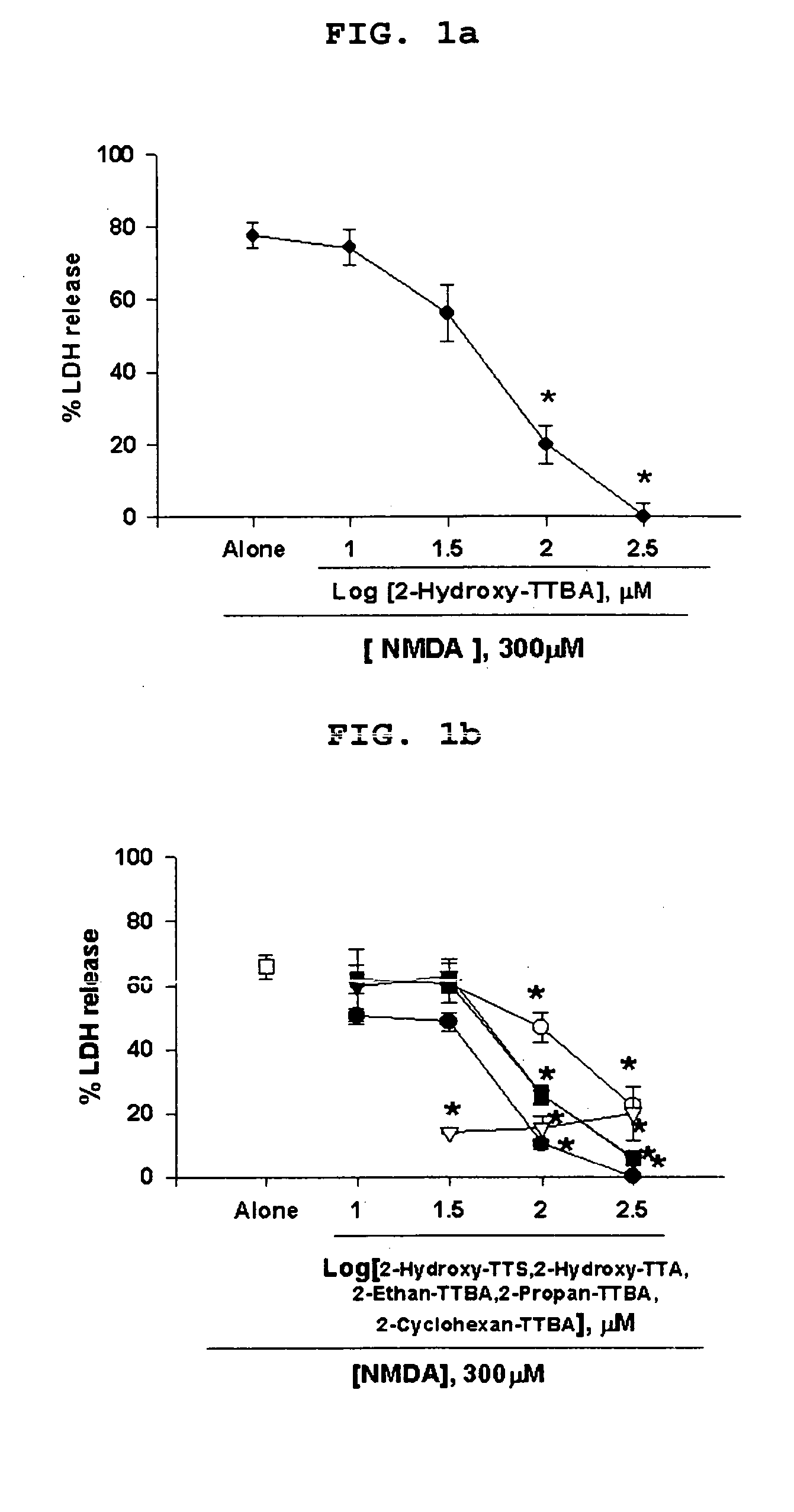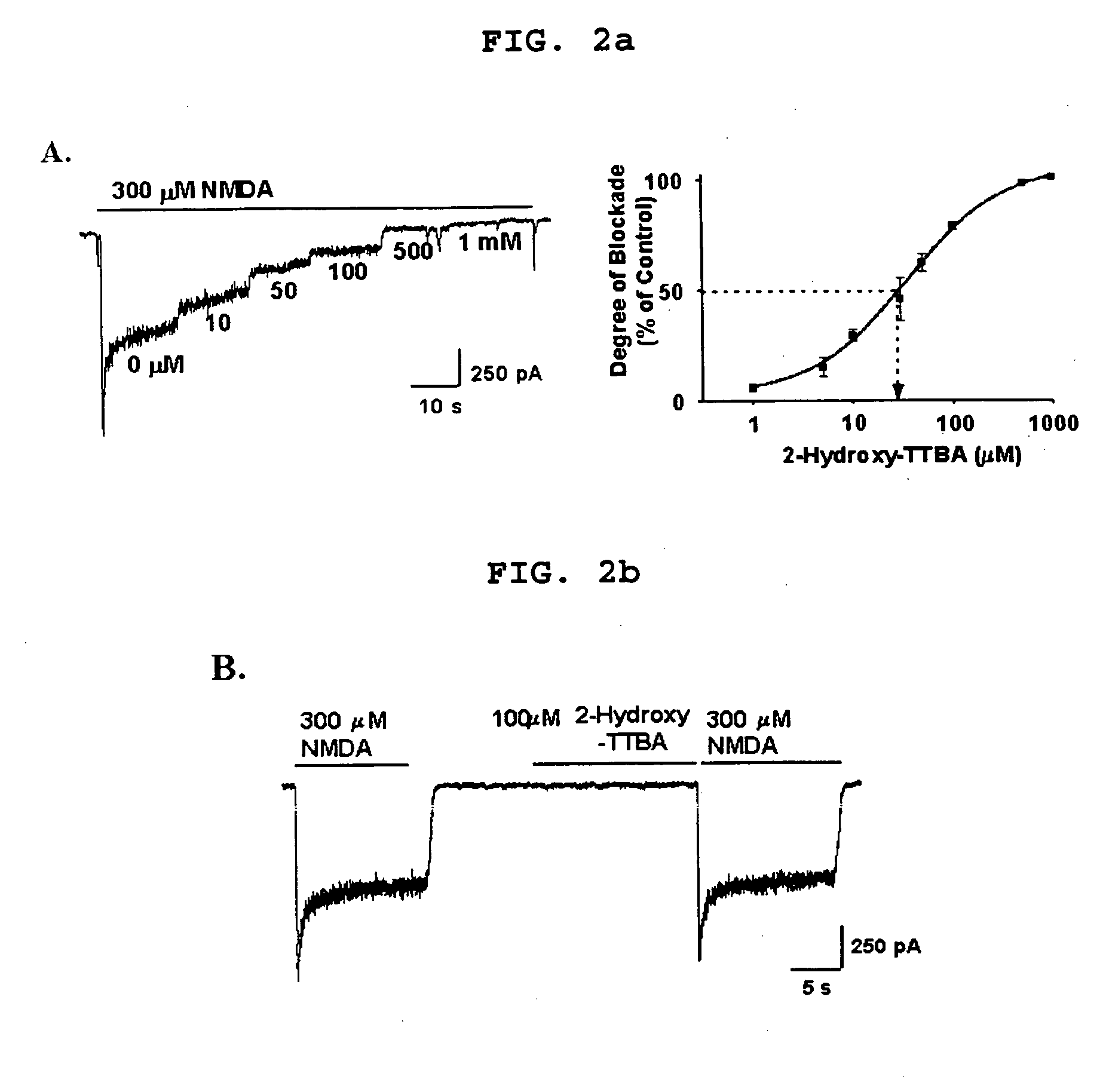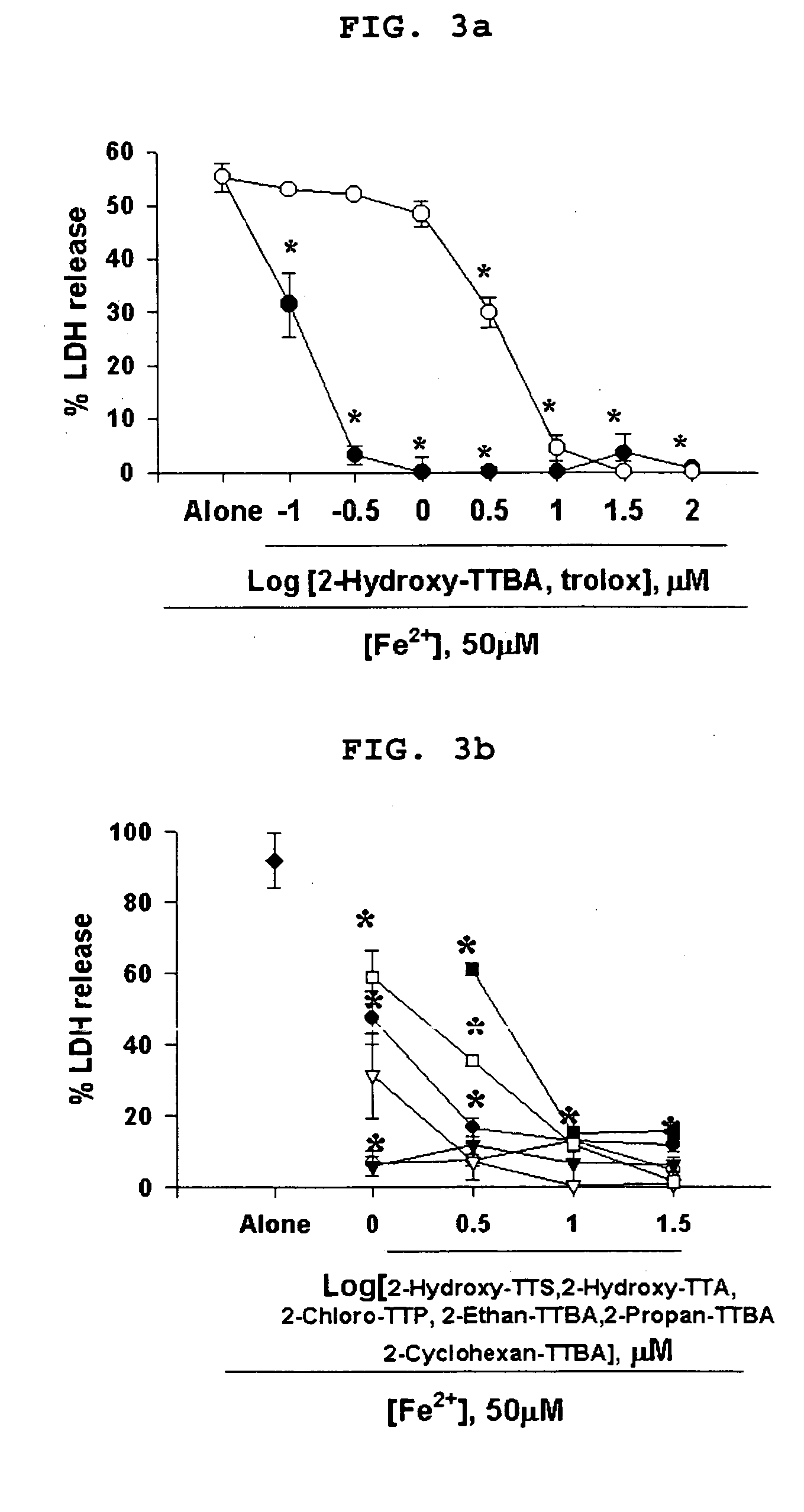Tetrafluorobenzyl derivatives and pharmaceutical composition for preventing and treating acute and chronic neurodegenerative diseases in central nervous system containing the same
a technology of tetrafluorobenzyl and derivatives, which is applied in the direction of anti-noxious agents, applications, peptides/protein ingredients, etc., can solve the problems of inability to cure the loss of essential brain functions, such as cognition, sensation, economic and social overload, and deprivation of oxygen and glucose, and achieves potent neuroprotective activity.
- Summary
- Abstract
- Description
- Claims
- Application Information
AI Technical Summary
Benefits of technology
Problems solved by technology
Method used
Image
Examples
example 2
Inhibitory Effects of Excitotoxicity by 2-hydroxy-TTBA, 2-hydroxy-TTA, 2-Hydroxy-TTS, 2-Ethan-TTBA, 2-Prppan-TTBA or 2-Cyclohexan-TTBA
[0245] At DIV 13-15 in mixed neuron-glia culture as shown in Example 1, cortical cell cultures were exposed to 300 μM NMDA for 10 min, alone or with 3-300 μM 2-Hydroxy-TTBA, 10-300 μM 2-Hydroxy-TTS, 30-300 μM 2-Hydroxy-TTA, 30-300 μM 2-Ethan-TTBA, 10-300 μM 2-Prppan-TTBA, or 10-300 μM 2-Cyclohexan-TTBA. Neuronal death was assessed 24 hr later by measuring amount of LDH released into the bathing medium. *, Significant difference from the vehicle control, p<0.05 using ANOVA and Student-Neuman-Keuls' test.
[0246] Cortical cell cultures exposed to 300 μM NMDA for 10 min underwent widespread neuronal death (approximately 75-80% neurons died) over the next 24 hr. NMDA-induced neuronal death was blocked by co-treatment with 2-Hydroxy-TTBA in a dose-dependent manner at doses of 10-300 μM (FIG. 1a).
[0247] Concurrent administration of 2-Hydroxy-TTS, 2-Hydroxy...
example 3
Blocking Effect of 2-Hydroxy-TTBA on NMDA-induced Inward Currents
[0248] Whole cell recordings were performed on cortical cell cultures at room temperature as described [Seo et al., J. Pharmacol. Exp. Ther., 299:377-384(2001)]. Typical NMDA-induced inward currents (NMDA currents) were evoked immediately after applying 300 μM NMDA to cultured cortical neurons which were held at −70 mV. Bath application of 2-Hydroxy-TTBA immediately depressed NMDA-evoked currents in a dose dependent manner (n=7-15 neurons / condition, IC50 value=30.55±2.96 MM) (FIG. 2a). Application of 100 μM 2-Hydroxy-TTBA alone had no effect on the holding currents and had little effect on the response of the cell to a subsequent treatment of 300 μM NMDA (FIG. 2b), suggesting that 2-Hydroxy-TTBA exerts antagonistic effect only when the NMDA receptor is activated (n=6).
example 4
Blockade of oxidative neuronal death by 2-Hydroxy-TTBA, 2-Hydroxy-TTA, 2-Hydroxy-TTS, 2-Chloro-TTP, 2-Ethan-TTBA, 2-Propan-TTBA or 2-Cyclohexan-TTBA
(4-1) Inhibition of FeCl2-induced free radical toxicity
[0249] Mixed cortical cell cultures (DIV 13-15) were continuously exposed to 50 μM FeCl2, which produces hydroxyl radical via a Fenton reaction, alone or with inclusion of 2-Hydroxy-TTBA, 2-Hydroxy-TTA, 2-Hydroxy-TTS, 2-Chloro-TTP, 2-Ethan-TTBA, 2-Propan-TTBA, 2-Cyclohexan-TTBA or trolox (a vitamin E analogue) at indicated doses. Neuronal cell death was analyzed 24 hr later by LDH assay as described above. *, Significant difference from the vehicle control (FeCl2), p<0.05 using ANOVA and Student-Neuman-Keuls' test.
[0250] Cortical cell cultures exposed to FeCl2 underwent widespread neuronal death over the next 24 hr. 2-Hydroxy-TTBA and trolox prevented FeCl2-induced free radical neurotoxicity in a dose-dependent manner. However, 2-Hydroxy-TTBA was 30-fold stronger than trolox in pr...
PUM
| Property | Measurement | Unit |
|---|---|---|
| pressure | aaaaa | aaaaa |
| diameter | aaaaa | aaaaa |
| time | aaaaa | aaaaa |
Abstract
Description
Claims
Application Information
 Login to View More
Login to View More - R&D
- Intellectual Property
- Life Sciences
- Materials
- Tech Scout
- Unparalleled Data Quality
- Higher Quality Content
- 60% Fewer Hallucinations
Browse by: Latest US Patents, China's latest patents, Technical Efficacy Thesaurus, Application Domain, Technology Topic, Popular Technical Reports.
© 2025 PatSnap. All rights reserved.Legal|Privacy policy|Modern Slavery Act Transparency Statement|Sitemap|About US| Contact US: help@patsnap.com



